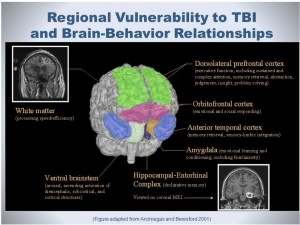Migraines
Migraines are likely to occur following a concussion for a number of reasons. Whether the concussion was due to an impact or non-impact injury, there has been damage to the brain. Following a traumatic brain injury, the brain is hypersensitive due to the ionic flux and glutamate release. Immediately after an injury to the brain, there is a large release of neurotransmitters and ions. Glutamate binds to NMDA receptors and an increased amount of it will lead to more depolarization in the neurons. Potassium efflux and calcium influx occur which shifts membrane potential. These changes in physiology cause issues for various other cell functions. Figure 1 describes the different types of headaches that can occur following a concussion. The type of headache someone is experiencing can help physicians determine what areas of the brain have been damaged.

Figure 1: A few of the different types of headaches someone could experience following a concussion.
Vulnerability to Further Injury
The sodium-potassium pump must now work harder in order to restore membrane potentials. The Na+/K+ requires ATP, so the body will divert more energy to the damaged brain areas. An increased amount of ATP triggers an increase in glucose metabolism. This increased glucose metabolism will not last for long; there is often a state of impaired metabolism following hyperglycolysis.
Cerebral blood flow is often reduced following a concussion. The increased demand for ATP along with the decreased blood flow causes further issues in the brain. Energy reserves in the brain are depleted because of the overall lack of energy, oxygen, and mitochondrial function. Metabolic pathways are altered after a concussion and take time to recover. It is unknown how much time is needed for the brain to fully recover following a TBI, but there is a period of vulnerability after it occurs. The altered state of the brain takes time to recover. It is possible for another injury to happen after a concussion and has the potential to cause even worse damage. Figure 2 shows some common areas that are affected after a TBI and what their primary functions are.

Figure 2: Areas of the brain often damaged during a TBI and what processes they are responsible for.
Slowed/Altered Cognition
Damage to the brain following a concussion can lead to a wide variety of symptoms. During a TBI, there is damage to axons. This can occur on a microscale and cause disruption of action potential transport, disconnection, and microhemorrhages. MRI has been used to measure how white matter changes following a concussion. Researchers are able to gain insight into how much axonal damage has occurred by observing white matter. Studies have shown that decreased or damaged white matter after a TBI can lead to a myriad of symptoms such as depression, PTSD, impaired memory, and behavioral changes.
The parts of the brain responsible for judgment, problem-solving, and arousal are often damaged during a concussion. These physiological changes help explain why many people experience cognitive alterations. People can have increased fear responses and higher levels of depression following a TBI. This video provides a good explanation of common emotional symptoms after a concussion and how to help someone experiencing these changes.
